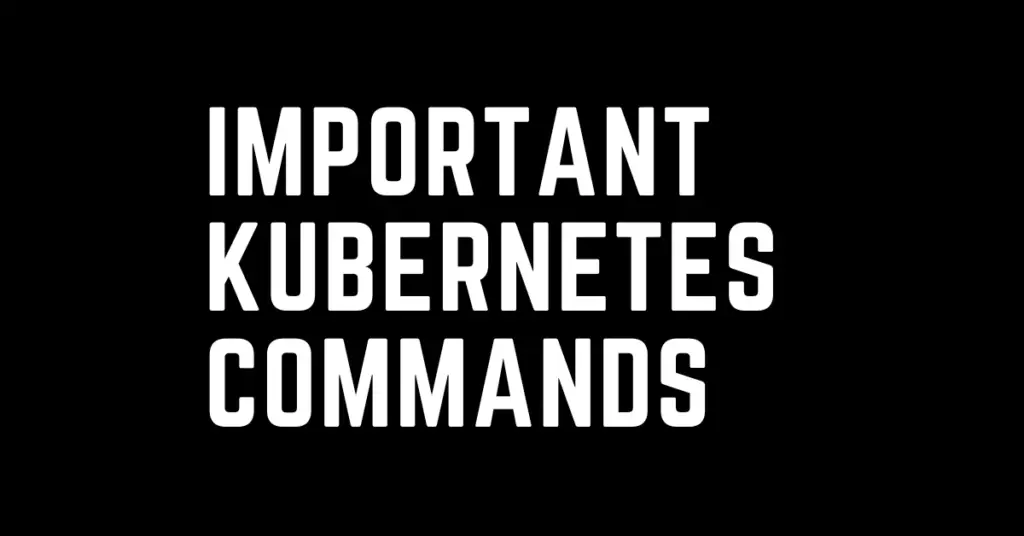Last Updated on March 4, 2023 by cscontents
Introduction
Kubernetes is one of the most popular container orchestration platforms. Kubernetes was originally developed by Google, but currently, it is maintained by CNCF (Cloud Native Computing Foundation).
If you would like some detailed high-level information about Kubernetes, please head over to the below article.
Introduction to Kubernetes | Background of Kubernetes
In this article, we will see some important commands using which we can interact with the Kubernetes cluster. Now, when we speak about commands, we need to have some CLI tool that provides us the interface to execute the commands. In the case of Kubernetes, the CLI tool is kubectl.
So, we will be discussing some important kubectl commands which can be used to interact with the Kubernetes cluster.
Kubectl Command Syntax
It is very important to understand and know the syntax of kubectl commands. If we understand the syntax it will be very simple for you to remember any command.
kubectl [command] [TYPE] [NAME] [flags]
In the above syntax –
- command: It specifies the operation which we want to perform.
- For example: create, get, delete, describe, logs,
- TYPE: It specifies the Kubernetes resource type. The spelling of this TYPE is case-insensitive. And we can mention singular, and plural forms.
- For example, pod, deployment, service,
- NAME: It specifies the Kubernetes resource name. These names are case-sensitive.
- For example, myapp-deployment, myapp-service, etc.
- flags: It specifies any optional flags.
We have understood the syntax of the kubectl commands. Now we will see some of the commands.
kubectl commands
Below are the kubectl commands.
kubectl command to create any resource: kubectl create/apply
There are two commands for creating any resource.
- kubectl create –
kubectl create -f <manifest file (YAML)> - kubectl apply –
kubectl apply -f <manifest file (YAML)>
Example using kubectl create:
kubectl create -f myapp-pod.yaml
kubectl create -f my-deployment.yaml
kubectl create -f my-service.yaml
Example using kubectl apply:
kubectl apply -f myapp-pod.yaml
kubectl apply -f my-deployment.yaml
kubectl apply -f my-service.yaml
kubectl command to update any resource: kubectl apply
To update any existing resource, we need to use the ‘kubectl apply’ command.
For example, you have updated the manifest file (YAML file) of a resource. Now, to apply the changes we can run this ‘kubectl apply’ command.
Example:
kubectl apply -f myapp-pod.yaml
kubectl apply -f my-deployment.yaml
kubectl apply -f my-service.yaml
kubectl command to get any resource: kubectl get
To get any resource from the Kubernetes cluster we need to use the ‘kubectl get’ command.
For example,
kubectl get pod
kubectl get po
kubectl get pods
We can use the short form for resources.
| pod (s) | po |
| deployment (s) | deploy |
| replicaset (s) | rs |
| service (s) | svc |
| daemonset (s) | ds |
| namespace (s) | ns |
| persistentvolume (s) | pv |
| persistentvolumeclaim (s) | pvc |
kubectl command to describe any resource: kubectl describe
To describe or to see the detail of any resource that is running in the Kubernetes cluster we need to use the ‘kubectl describe’ command.
Example:
kubectl describe pod my-sample-pod
kubectl describe deploy my-sample-deploy
kubectl describe svc my-sample-svc
kubectl command to edit/modify/update any running resource: kubectl edit
To edit//modify/update any running resource that is running in the Kubernetes cluster we need to edit its configuration/manifest file (YAML file). To do this we need to use the ‘kubectl edit’ command. This command will open up the YAML configuration file in the default test editor and you can do the changes & save the file to apply the changes.
This ‘kubectl edit’ command can be used to update/modify any Kubernetes object like deployments, pods, config maps, etc.
Example:
kubectl edit deployment my-sample-deployment
The above command will open the configuration of ‘my-sample-deployment’ in the default text editor. And once you update the configuration file, it will override the existing configuration.
It is recommended not to use the ‘kubectl edit’ command directly to modify/update resources in the production cluster. Instead, you can create/update a separate configuration file & use the ‘kubectl apply’ command and at first, apply it in a test environment.
kubectl command to check logs of any resource: kubectl logs
To check or print the logs of any Kubernetes resource we need to use the ‘kubectl logs’ command.
Example:
kubectl logs my-sample-pod -c my-container
This command will show the logs of the container with the name ‘my-container’ that is running inside my-sample-pod.
kubectl command to run commands inside a container: kubectl exec
To execute any command inside a container that is running in a pod we need to use the ‘kubectl exec’ command. This command can be used to troubleshoot issues with that pod.
kubectl exec my-sample-pod -c my-container -- ls /
The above command will execute the ‘ls /’ command in the container with the name ‘my-container’ that is running inside my-sample-pod.
kubectl command to delete any resource: kubectl delete
To delete any resource that is running in the Kubernetes cluster, we need to use the ‘kubectl delete’ command. It is used to delete any pods, deployments, services, etc.
Example:
kubectl delete pod my-sample-pod
kubectl delete deploy my-sample-deployment
kubectl delete svc my-sample-svc
kubectl command to scale any deployment: kubectl scale
To scale the number of replicas in a deployment we need to use the ‘kubectl scale’ command. This command can be used to increase/decrease the number of replicas in a deployment.
Example:
kubectl scale deployment my-sample-deployment --replicas=4
The above command will scale the number of replicas in the deployment with the name ‘my-sample-deployment’ to 4 replicas.
e.g., If the number of existing replicas is 2, then you can upscale it to 4. If the number of existing replicas is 4 then you can downscale it to 2. This is just an example, you can upscale/downscale according to your requirement.
Thank you.
If you are interested in learning DevOps, please have a look at the below articles, which will help you greatly.
- How to create ansible role for Java installation – a simple guide
- Kubernetes Series: Part 1 – Introduction to Kubernetes | Background of Kubernetes
- Kubernetes Series: Part 2 – Components of Kubernetes cluster | Kubernetes cluster in detail
- Kubernetes Series: Part 3 – What is Minikube and How to create a Kubernetes cluster (on Linux) using Minikube?
- Introduction to Ansible | High-Level Understanding of Ansible
- Basics of automation using Ansible | Automate any task
- 10 frequently used ansible modules with example
- Jenkins Pipeline as code – High-level information
- What is End-to-End Monitoring of any web application and Why do we need it?
- What is “Monitoring” in DevOps? Why do we need to Monitor App/DB servers, Transactions etc.?
- DevOps Engineer or Software Developer Engineer which is better for you?- Let’s discuss
- How To Be A Good DevOps Engineer?
- How to do git push, git pull, git add, git commit etc. with Bitbucket

